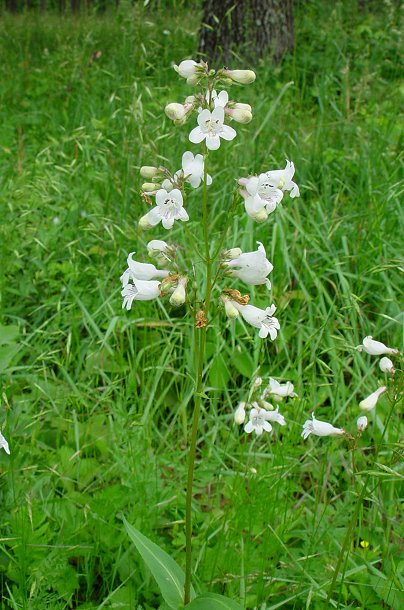Penstemon digitalis Nutt. ex Sims
Smooth Beard-Tongue

Native
CC = 3
CW = 0
MOC = 79
© DETenaglia
Penstemon digitalis Nutt. ex SimsSmooth Beard-Tongue | |
 |
Native CC = 3 CW = 0 MOC = 79 |
© DETenaglia |
|
Family - Plantaginaceae Habit - Perennial forb, from a thick caudex. Stems - Ascending to erect, to 90 cm, usually glabrous, but sometimes moderately to densely pubescent toward the tip with minute, usually nonglandular hairs, these often in longitudinal lines, green to olive green or more commonly purplish-tinged, at least toward the base, often somewhat shiny, not glaucous.
Leaves - Basal and opposite, simple. Basal leaves 3-20 cm long, the blade oblanceolate to spatulate or obovate, rounded to bluntly or sharply pointed at the tip, tapered basally to a usually winged petiole, the margins entire or nearly so or bluntly to sharply and sometimes finely toothed, the surfaces glabrous or occasionally minutely hairy along the main veins, the undersurface often dotted with minute sessile glands, not glaucous. Stem leaves 2.5-18.0 cm long, the lowermost with the blade oblanceolate to narrowly oblong-elliptic, grading into ovate, lanceolate, or narrowly lanceolate toward the stem tip, mostly sharply pointed at the tip, sessile or nearly so, the base of the lower blades tapered, grading through rounded to those of at least the uppermost leaves often shallowly cordate and clasping, the margins variously entire to bluntly or sharply, irregularly, and sometimes minutely toothed, the surfaces glabrous or occasionally minutely hairy along the main veins, the undersurface often dotted with minute sessile glands, not glaucous.
Inflorescences - Narrow to more broadly pyramidal panicles, the central axis sparsely to moderately glandular-hairy, sometimes also nonglandular-hairy, green or purplish-tinged, not glaucous, with 3-6 nodes, each with a pair of relatively small, linear to narrowly lanceolate, somewhat clasping bracts, the branches ascending or arched upward, with a pair of few- to several-branched clusters per node, each main branch with 3-18 flowers.
Flowers - Calyces 4-8 mm long at flowering, moderately to densely glandular-hairy, not glaucous, the lobes narrowly ovate to ovate, sharply pointed. Corollas 20-30 mm long, the tube abruptly enlarged at or more commonly below the midpoint, strongly bilabiate, the upper lip spreading to slightly recurved, the lower lip spreading to strongly arched downward, not projecting significantly beyond the upper lip, white or occasionally pale pinkish-to purplish-tinged, the throat not appearing flattened, only slightly 2-ridged and usually lined with purple and/or pink and occasionally also yellow nectar guides on the lower side, minutely glandular-hairy externally and sparsely to moderately nonglandular-hairy in the throat. Staminode white, strongly flattened toward the tip, sometimes somewhat curved or curled downward apically, bearded on the upper surface above the midpoint, the hairs yellow or purple toward the base, yellow to yellowish brown toward the tip. Stamens 4. Filaments to 2 cm long, white, glabrous. Anthers purplish-black, 3 mm long. Style 2 cm long, white, glabrous. Ovary green, glabrous, 4 mm long.
Fruits - Ovoid capsules 10-15 mm long. Seeds 0.8-1.3 mm long, tan to dark brown or black, the tan to reddish brown ridges sometimes well-developed.
Flowering - April - June. Habitat - Forests, savannas, glades, ledges and tops of bluffs, prairies, sloughs, oxbows, streambanks, marshes, pastures, fields, railroads, roadsides. Origin - Native to the U.S. Lookalikes - Other species of Penstemon, especially P. arkansanus, P. pallidus. Other info. - This is the most common species of Penstemon in Missouri, being found in almost every county except in the extreme northwest corner of the state. Its main range extends in a wide, curving band from Louisiana northward to Wisconsin and eastward into New England, also reaching into Canada. The plant is easily recognized as a Penstemon by the opposite leaves and distinctively shaped flowers and inflorescence. Identification to species requires a bit more care, as many species of Penstemon appear similar. This one has leaves and stems which are glabrous or nearly so (ignore glandularity in the inflorescence), and flowers which are distinctly bilabiate, with well-defined upper and lower lips. The lower lip in this species generally points downward rather than straight out. The flowers of this species are larger than those of P. arkansanus. Various infraspecific forms of this plant have been described, based upon flower size, presence of whorled leaves at nodes, and other attributes. Photographs taken off Hwy V, Shannon County, MO., 5-23-03 (DETenaglia); also at Shaw Nature Reserve, Franklin County, MO, 5-23-2008, and Weldon Spring Conservation Area, St. Charles County, MO, 7-26-2010 and 5-23-2014 (SRTurner). |